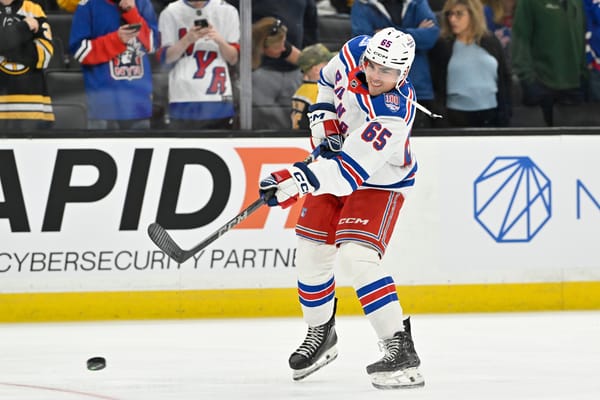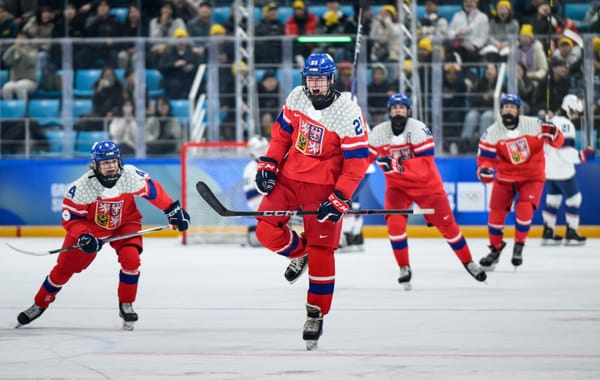Context Will Be Important When Evaluating Vitali Kravtsov’s Post-Draft Season
The Rangers 2018 first-rounder had been considering joining the Hartford Wolf Pack
News broke that Vitali Kravtsov was remaining in the KHL with Traktor Chelyabinsk, and the reaction was mixed among readers of Blueshirt Banter. As I write this story, 43 percent of readers wanted Kravtsov to remain in the KHL, 41 percent wanted him to join the Hartford Wolf Pack, and the remaining 16 percent wanted him to be a Broadway Blueshirt on opening night.
Some of the comments ranged from it being good that both Kravtsov and the Rangers realized that another year overseas made sense, to there being disdain that he was yet another high pick that wasn’t going to be playing in the NHL. Everyone is entitled to their own opinion, but the fact remains that he isn’t going to be in North America until March or April depending on how Traktor fares in the regular season. What that means is that once again we will be monitoring the KHL’s site for stats, and heavily using Google Translate to follow the 6’4”, 183 pound winger’s exploits in Russia as the season goes on.
So, I thought it would be useful to take a look at some players who were drafted and spent their post-draft season playing in Russia. If there’s a basic understanding of what a “good” and “bad” season looks like, it will be easier to understand where he stacks up as the season progresses. It is also important to have context of where a player was, and what they turned into. Not only will he be measured against those who played in Russia, but as a No. 9 overall pick Kravtsov he will be compared to others drafted in that position.
Circling back to performance in relation to his fellow countrymen, too often there is criticism of continually comparing Russian prospects to Nikita Kucherov, Vladimir Tarasenko and Evgeny Kuznetsov. This is because these three players are elite, and some feel that using them can be a reach at times. I can see where people are coming from when they say that, therefore not only am I going to look at how they fared in their post-draft season, but I am going to include stats on 17 other players.
The numbers cited will below feature raw totals and NHLe, which represents expected NHL points. Emmanuel Perry, founder of Corsica.Hockey, just released an updated set of conversion factors which give us a way to a look at production in a variety of leagues and get a sense of what that translates to at the NHL level — although, there are no guarantees of play translating to the NHL. What you will notice, however, is some of the more notable players put up better number than others, how it then translated to future NHL success. Again, this is just one method and it is not an exact science, but it is one of the better tools available currently.
Before we start: if there’s a notable player you feel that is missing, feel free to point them out. I tried not to go too far back, first starting with first round talent and then expanding it to those who have had some notable success at the NHL level; I then included recent draft picks. Overall, I think you will find that it is a diverse sample for the purposes of this exercise.
With that said, here is a list of notable players who were drafted in the NHL and spent their next season playing in Russia.
Eeli Tolvanen, Evgeny Kuznetsov, Nikolay Kulemin, Alexander Ovechkin and Evgeni Malkin make up the top five. Of this list, you have two of the best players in league history (Ovechkin, Malkin), one of the league’s emerging talents in Kuznetsov, a top prospect in Tolvanen, and Nikolay Kulemin who showed spurts of brilliance but never reached his potential.
The bottom five features Maxim Afinogenov, Alexander Semin, Artem Anisimov, Marko Dano, and Denis Gurianov. This list has varying levels of skill, as it features Afinogenov who was all over the place during his career, a very talented Semin who fizzled out of the league, a decent second-line center in Anisimov, prospect Marko Dano who is looking for an extended opportunity to break out, and Denis Gurianov, a 21-year-old prospect who was a surprising pick at No. 12 overall in 2015, spent 131 games in the AHL, and has 61 points to his name.
It is easy to see the chasm in pure talent between the top five and the bottom five, and that provides a baseline. There are extraneous factors like ice time which are not accounted here, and that’s because data isn’t kept quite as good overseas as it is here. It should also be noted that Nikita Kucherov, whose post draft season was in the MHL, is .20 better than Afinogenov here and we can see what he’s gone on to do.
Conversely, we have Pavel Buchnevich who comes in at a post draft NHLe of 27.5 which was two points better than Kucherov, and he went on tally 20 points in his first NHL season which factors out to 40 points in an 82-game campaign; his second season saw him on pace to finish with 48 points. The point here is that a lot can change through development, and there’s a wide range of results among these players.
Just outside the top five are Mikhail Grabovski, Alexei Cherepanov, Yegor Korshkov, Krill Kaprizov, and Vladimir Tarasenko. Of this list you have Grabovski who I’d call a good top-nine forward whose game was impacted by injuries, a very good prospect in Kaprizov, a decent one in Korshkov, and then a bona fide superstar in Tarasenko. I leave Cherepanov for last because his story is a tragic one.
It was stunning that he fell to the Rangers at No. 17 overall as he was a highly touted prospect who was ranked No. 5 by TSN. For whatever reason, most likely the “Russian factor,” he slid down the board and the Rangers scooped him up without hesitation.
In the clip it makes mention that he was committed to one more year in the KHL; in that season he tallied 15 goals and 12 assists for 27 points in 46 games. Instead of joining the Rangers, Cherepanov decided to stay one more and he was off to amazing start with 13 points in 15 games. By all accounts he was well on his way to becoming a superstar before tragedy struck. Cherepanov tragically died on the bench during a KHL game on October 13, 2008. His cause of death was a heart attack, and an investigation was held which resulted in five executives and doctors receiving a ban from the KHL.
The men -- including the former team president and general manager of Avangard Omsk, the team Cherepanov was playing for, and two team doctors -- were banned following a KHL investigation, which concluded that the parties involved “exhibited criminal negligence” in their duties and knowingly tried to treat Cherepanov’s life-threatening heart condition on their own.
The league also clarified earlier media reports that stated Cherepanov had been using performance-enhancing drugs, explaining that what had been reported as doping was in fact an attempt to treat Cherepanov’s heart condition.
Cherepanov’s agent, Jay Grossman, declined comment when contacted by ESPN.com.
Cherepanov, 19, collapsed Oct. 13 while on the bench for Avangard Omsk and died a short time later. The league said Friday that Cherepanov had suffered from chronic myocarditis and that the cause of his death was acute heart failure.
Cherepanov’s death could have been prevented, and the situation remains one of the most tragic incidents involving the hockey world in recent memory.
Overall, the blend in that middle group is vast and offers a range of possibilities. When looking at the total list, it is clear that quite a few players who spent their post draft season in Russia have gone on to have a decent NHL career. There were also some players who flopped. The mixed bag of results could be applied to North American skaters as well, but for some reason Russians are judged more harshly.
By all accounts Kravtsov is going to have a prominent top-six role with Traktor and he will be put in a position to succeed. While it would have been good to have Kravtsov a ride on I-95 away, there could have been the temptation to give him a taste of the NHL to start the season.
Giving him the space to grow into a new role before taking on a new league is also something worth considering. Given his importance to the organization, I am sure the team will be keeping close tabs on him and will visit him overseas if and when it is appropriate.
The skill level Kravtsov possesses is evident, and he represents a big part of the Rangers future.
His 2016-17 season with Belye Medvedi Chelyabinsk was highlighted by 36 points in 41 regular season games iand six points in five playoff games as 17 year old. His regular season total that year was third best among U18 players. That earned him a promotion to the KHL.
On draft day, Sam Cosentino of Sportsnet pointed out that he averaged 13 minutes per game during a playoff run which saw him break Kuznetsov’s scoring record for an U20 player. This was an increase over the nine minutes a game he averaged during the regular season. He also mentioned that during the Olympics he played in the VHL, which in Russia is equivalent to the AHL, and he tallied seven points in nine games (NHLe of 21.8)
During the 2018-19 KHL campaign he will receive a lot of attention and hopefully this time next year there will be conversations on how he’s going to fit in the Blueshirts’ top six. However, there still is a chance that the Rangers could see him for a brief stint this season.
In an NHL.com story, Gordie Clark said that Kravtsov is ready to play in North America, but both parties felt it was best he spend one more season in the KHL.
He still can personally buy out his KHL contract, but after discussing that option with the Rangers, all parties involved agreed it would be beneficial for Kravtsov to play one more KHL season before coming to North America, according to a Rangers spokesperson.
Kravtsov’s intention is to still play in North America this season, either with the Rangers or with Hartford of the American Hockey League, because of the timing of the KHL season.
He expects to be released from his KHL contract immediately after Traktor Chelyabinsk plays its final game, which could be as early as Feb. 22.
”He’s ready to start playing here,” Clark said.
For all we know Kravtsov could have an amazing season and lead Traktor to the Gagarin Cup Final which stretches into April. There’s no way of telling what will happen, so for now, we wait until his season begins and then the fun of #KravtsovWatch can begin.
Stats via Elite-Prospects unless otherwise noted.





